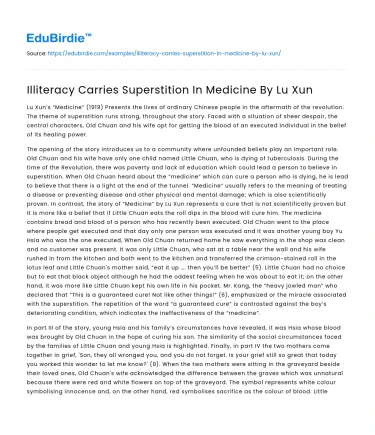Lu Xun’s “Medicine” (1919) Presents the lives of ordinary Chinese people in the aftermath of the revolution. The theme of superstition runs strong, throughout the story. Faced with a situation of sheer despair, the central characters, Old Chuan and his wife opt for getting the blood of an executed individual in the belief of its healing power.
The opening of the story introduces us to a community where unfounded beliefs play an important role. Old Chuan and his wife have only one child named Little Chuan, who is dying of tuberculosis. During the time of the Revolution, there was poverty and lack of education which could lead a person to believe in superstition. When Old Chuan heard about the “medicine” which can cure a person who is dying, he is lead to believe that there is a light at the end of the tunnel. “Medicine” usually refers to the meaning of treating a disease or preventing disease and other physical and mental damage; which is also scientifically proven. In contrast, the story of “Medicine” by Lu Xun represents a cure that is not scientifically proven but it is more like a belief that if Little Chuan eats the roll dips in the blood will cure him. The medicine contains bread and blood of a person who has recently been executed. Old Chuan went to the place where people get executed and that day only one person was executed and it was another young boy Yu Hsia who was the one executed, When Old Chuan returned home he saw everything in the shop was clean and no customer was present. It was only Little Chuan, who sat at a table near the wall and his wife rushed in from the kitchen and both went to the kitchen and transferred the crimson-stained roll in the lotus leaf and Little Chuan's mother said, “eat it up …. then you’ll be better” (5). Little Chuan had no choice but to eat that black object although he had the oddest feeling when he was about to eat it; on the other hand, it was more like Little Chuan kept his own life in his pocket. Mr. Kang, the “heavy jowled man” who declared that “This is a guaranteed cure! Not like other things!” (6), emphasized or the miracle associated with the superstition. The repetition of the word “a guaranteed cure” is contrasted against the boy’s deteriorating condition, which indicates the ineffectiveness of the “medicine”.
Save your time!
We can take care of your essay
- Proper editing and formatting
- Free revision, title page, and bibliography
- Flexible prices and money-back guarantee
In part III of the story, young Hsia and his family’s circumstances have revealed, it was Hsia whose blood was brought by Old Chuan in the hope of curing his son. The similarity of the social circumstances faced by the families of Little Chuan and young Hsia is highlighted. Finally, in part IV the two mothers come together in grief, 'Son, they all wronged you, and you do not forget. Is your grief still so great that today you worked this wonder to let me know?' (9). When the two mothers were sitting in the graveyard beside their loved ones, Old Chuan's wife acknowledged the difference between the graves which was unnatural because there were red and white flowers on top of the graveyard. The symbol represents white colour symbolising innocence and, on the other hand, red symbolises sacrifice as the colour of blood. Little Chuan and young Hsia both was the victim of the situation. In comparison to the story of the period and modern-day life, all changes over time, there was no physician or hospital during that era of revolution where they could find medicine and proper treatment to illuminate superstition as a belief that is not scientifically proven. In the end, the two mothers desperately want to know that their sons are in comfort and trying to interconnect to the soul, through the 'crow' which symbolizes the last farewell. Though the crow doesn't move at the time, it flies away as the two mothers prepare to leave. The flight of the crow remains open for interpretation. The central characteristic of the story also shows the admiration of love and loyalty toward their loved ones.
In conclusion, the mother asking for the sign is a definite superstition. The whole idea of the unfounded belief was that Old Chuan can bring happiness to his home which was disappeared because of his son’s sickness. The people believe in superstition because at that time they were only thinking about their son, they have a belief that their son will be recovered. Though the “medicine” was not effective in curing but, it did bring temporary happiness. However, it did not comfort the child but it comforted everyone psychologically to believe that everything will be well.






 Stuck on your essay?
Stuck on your essay?

